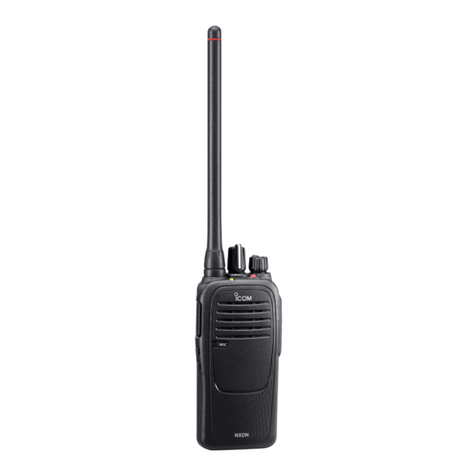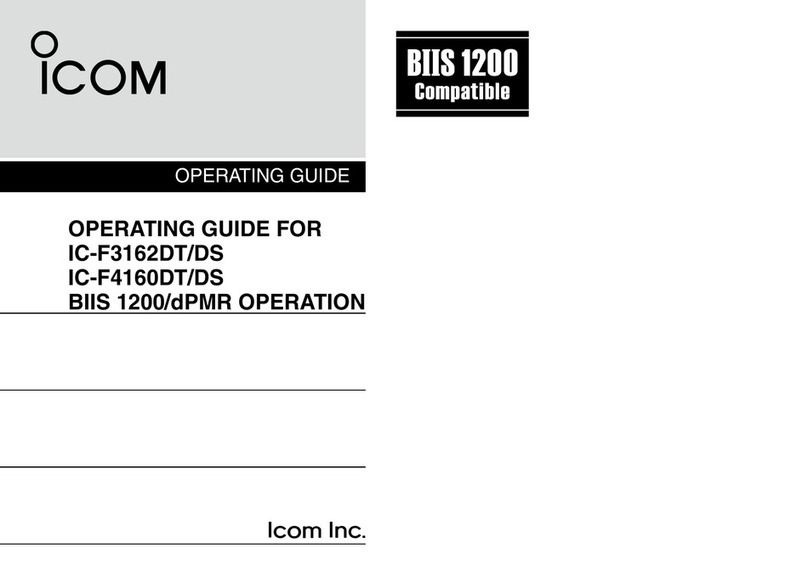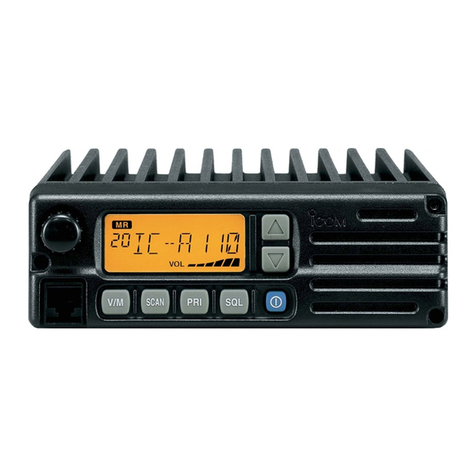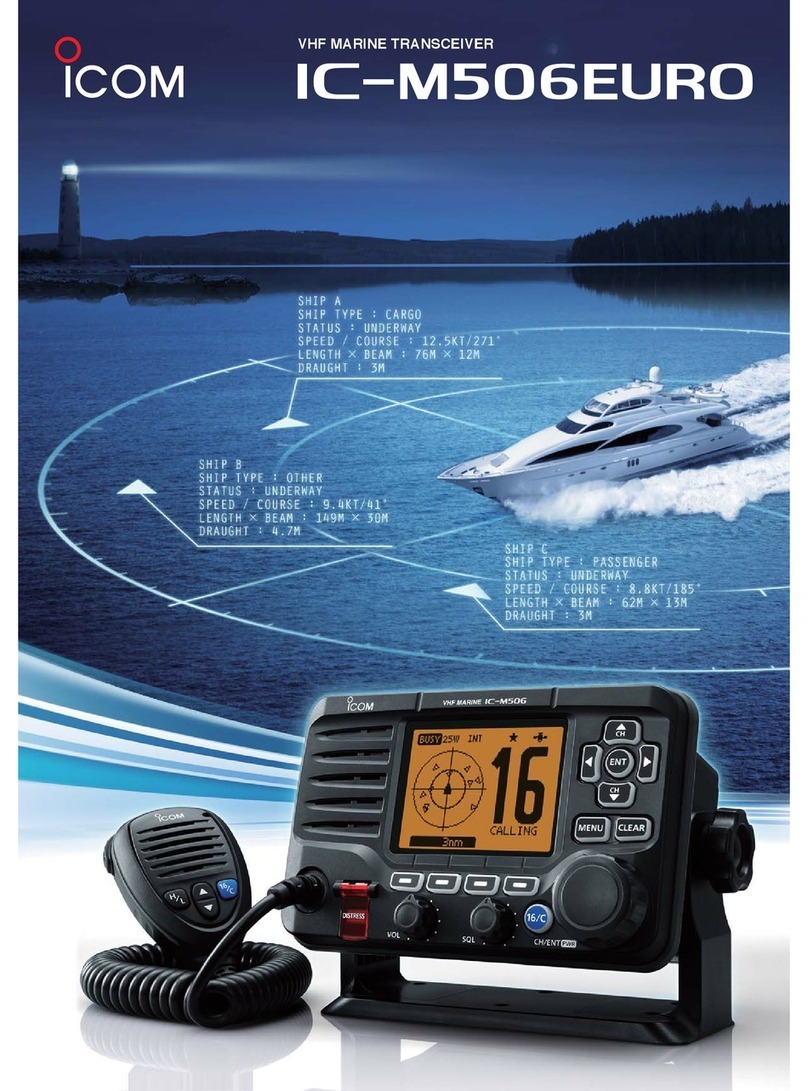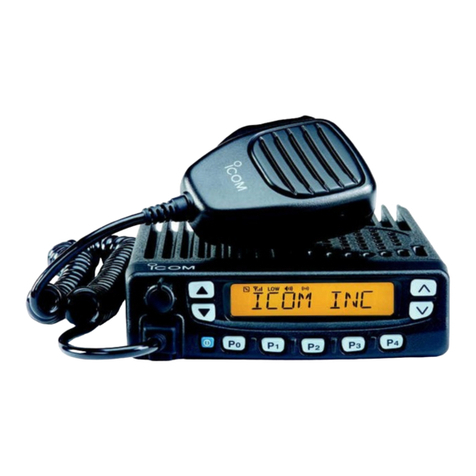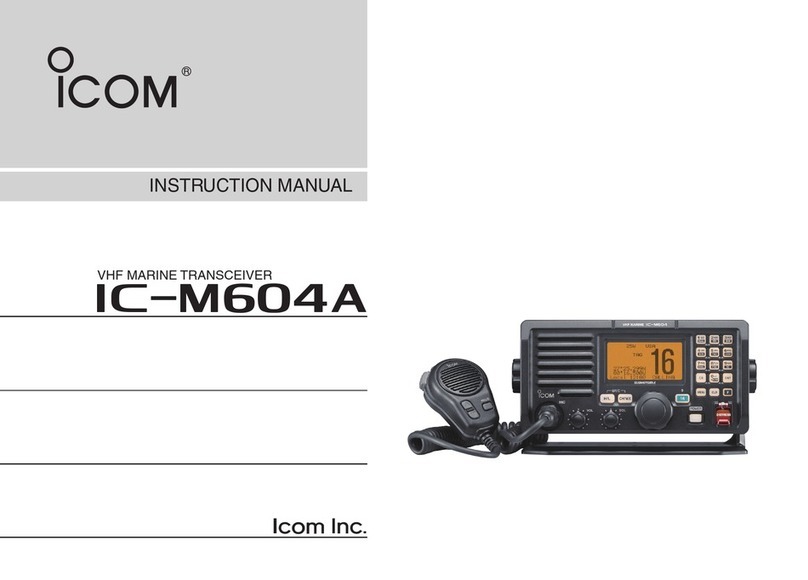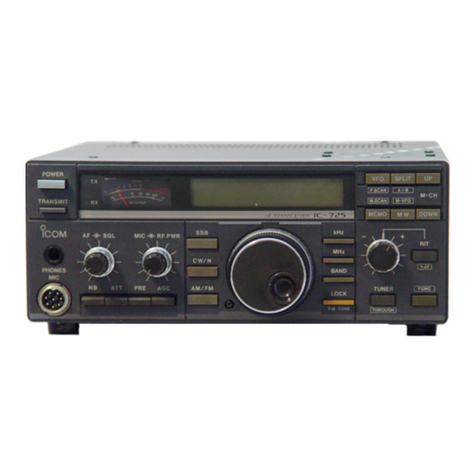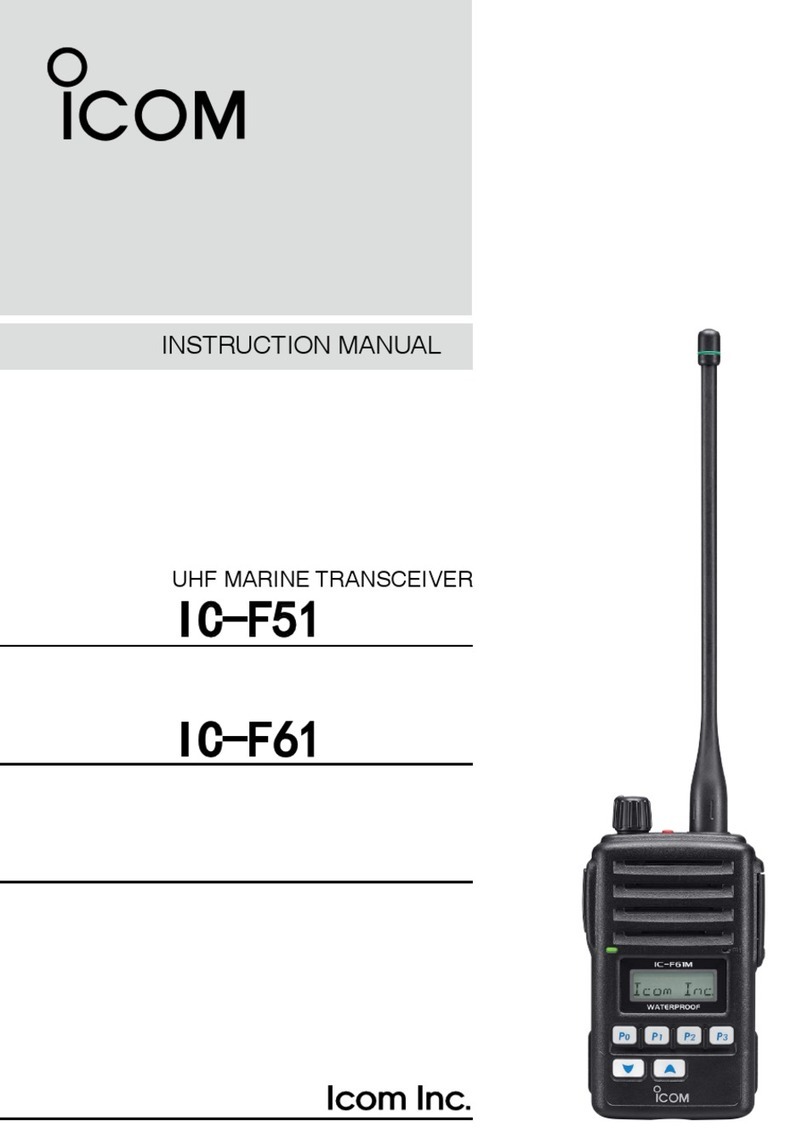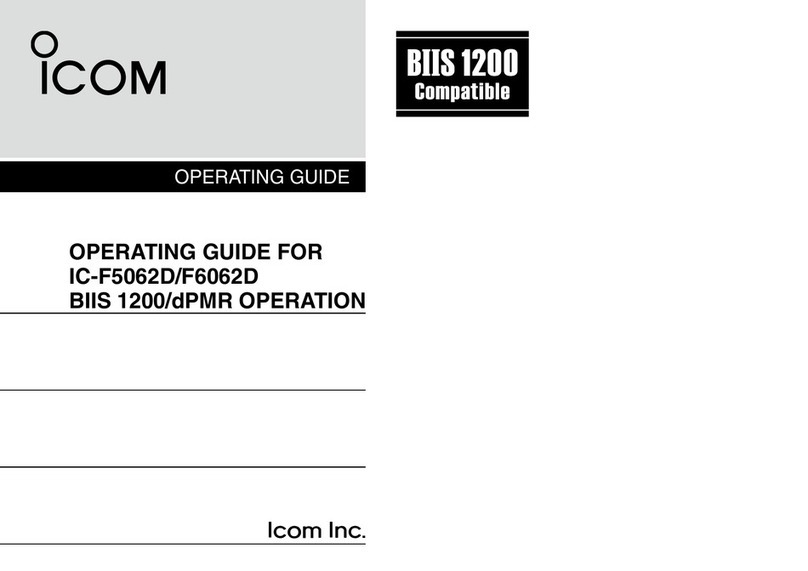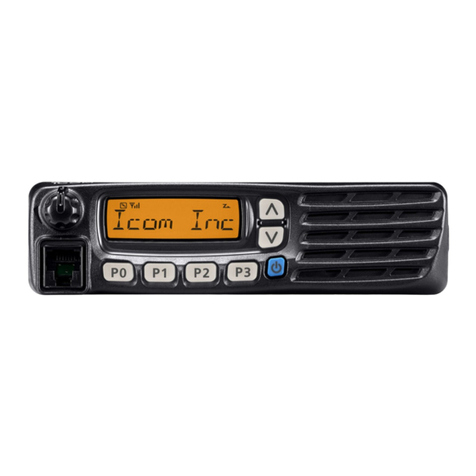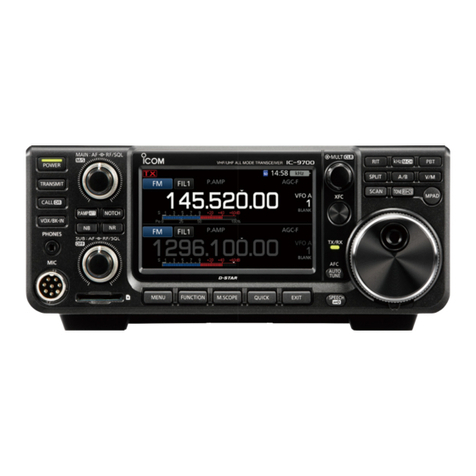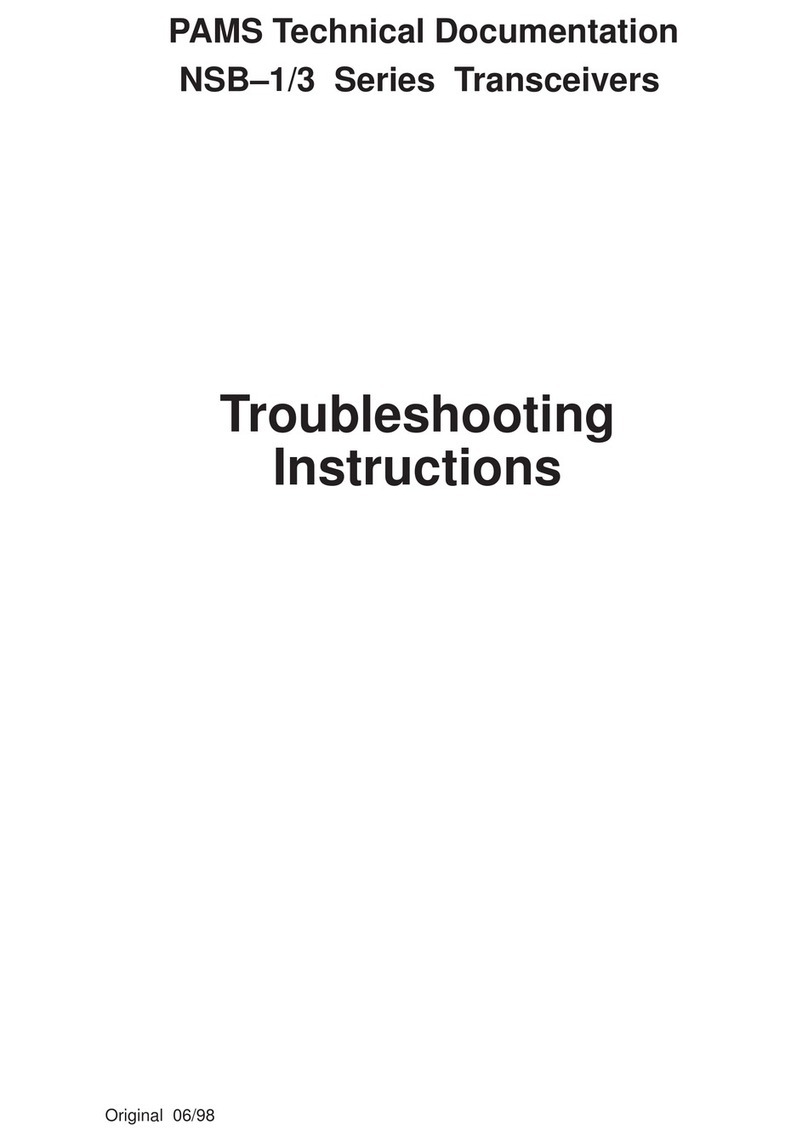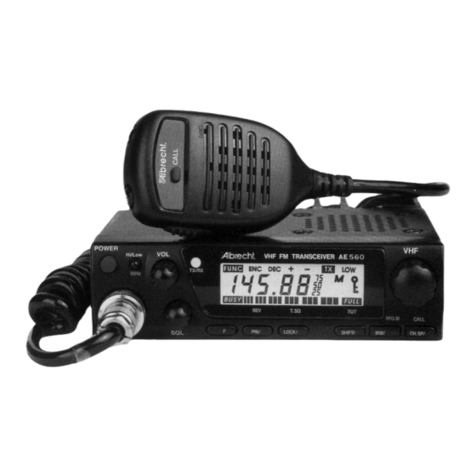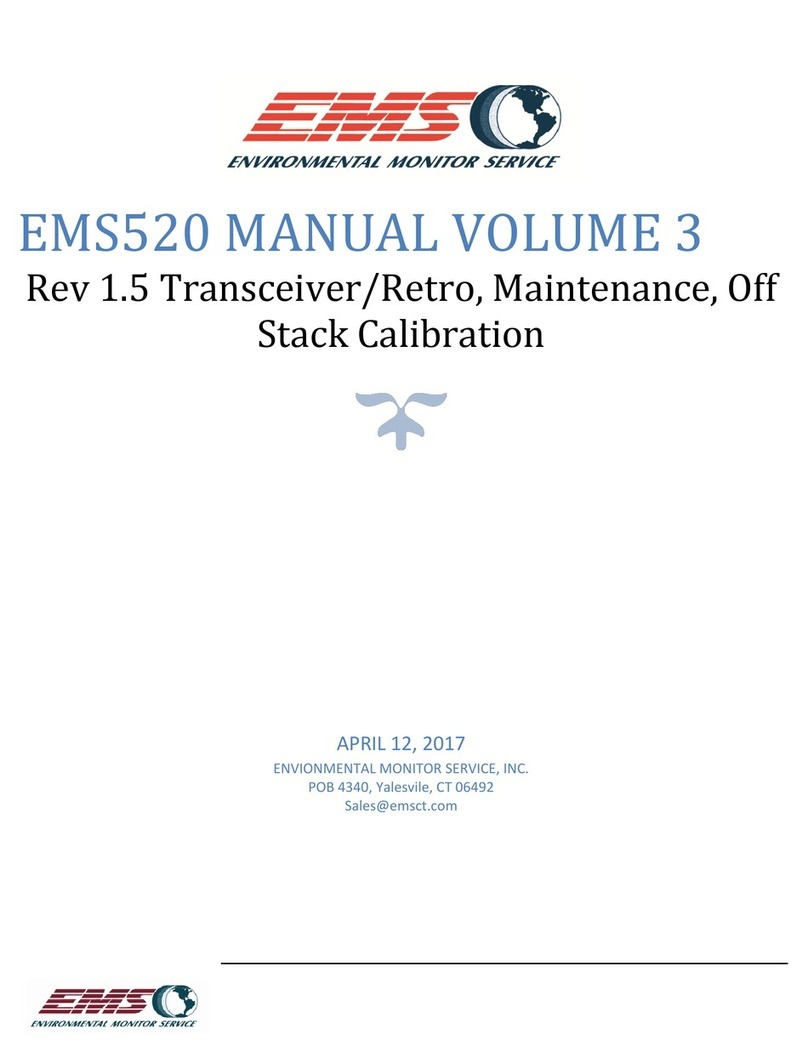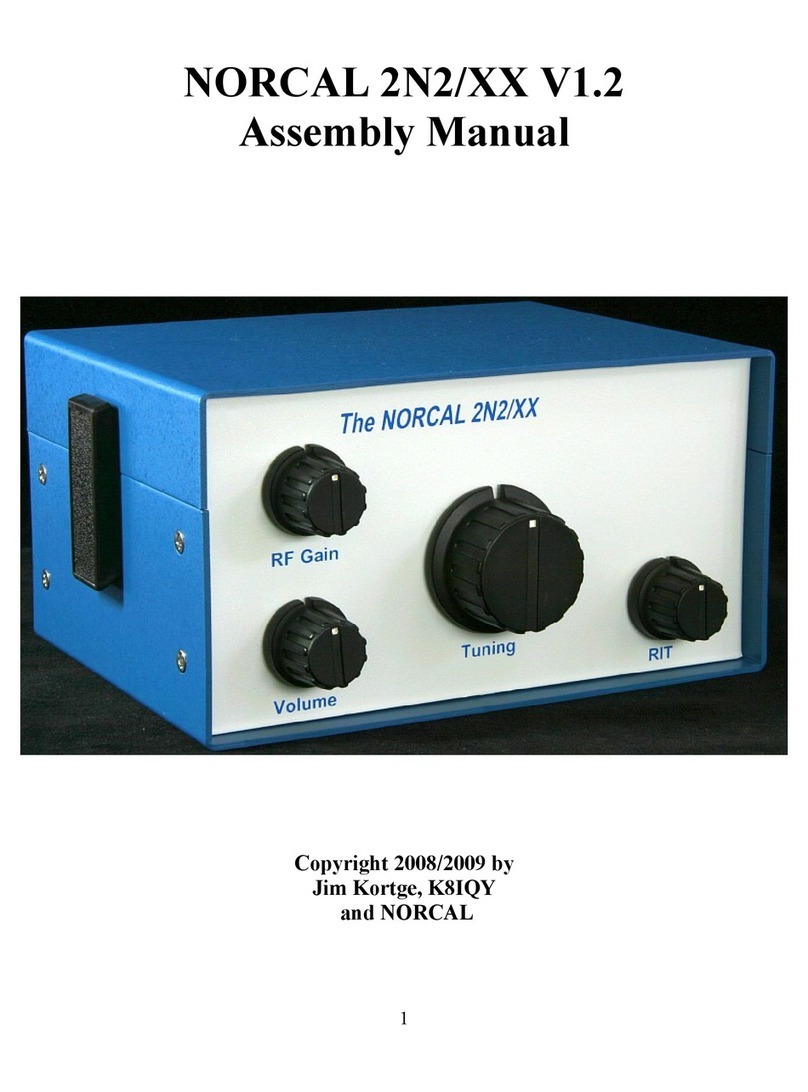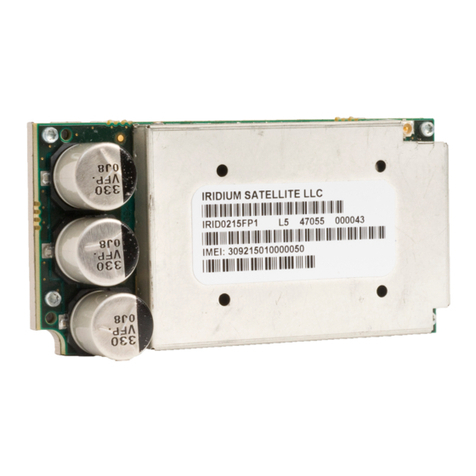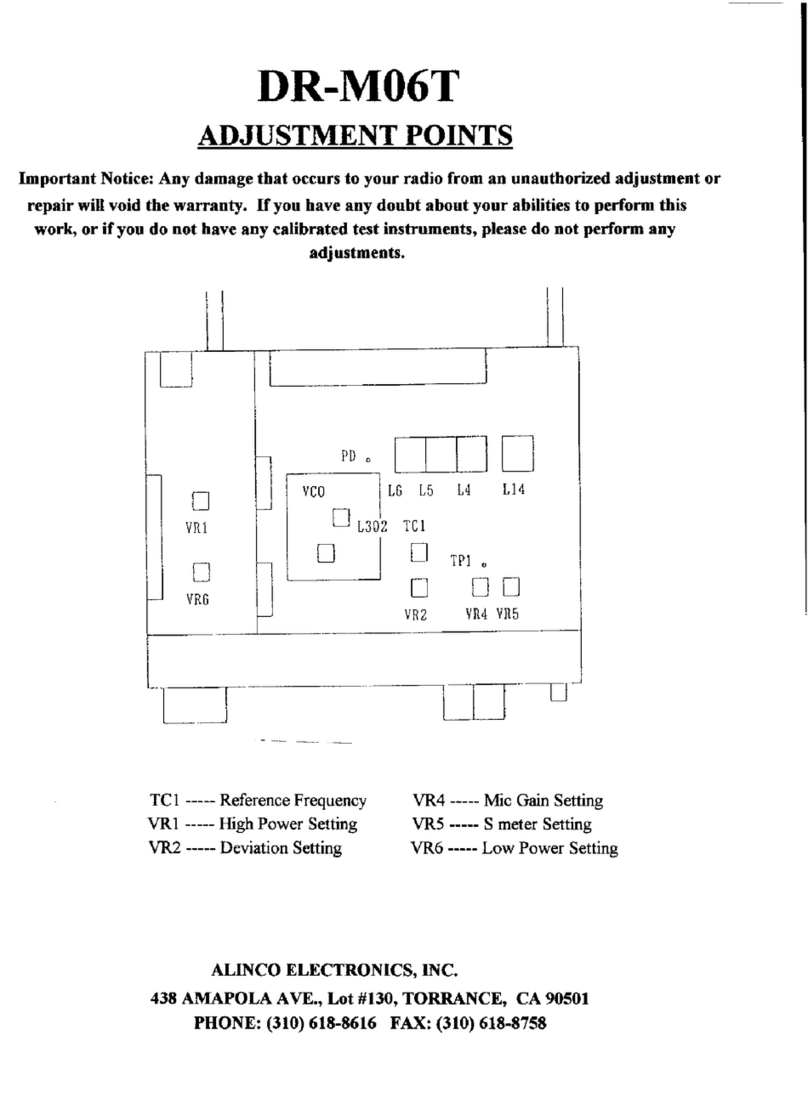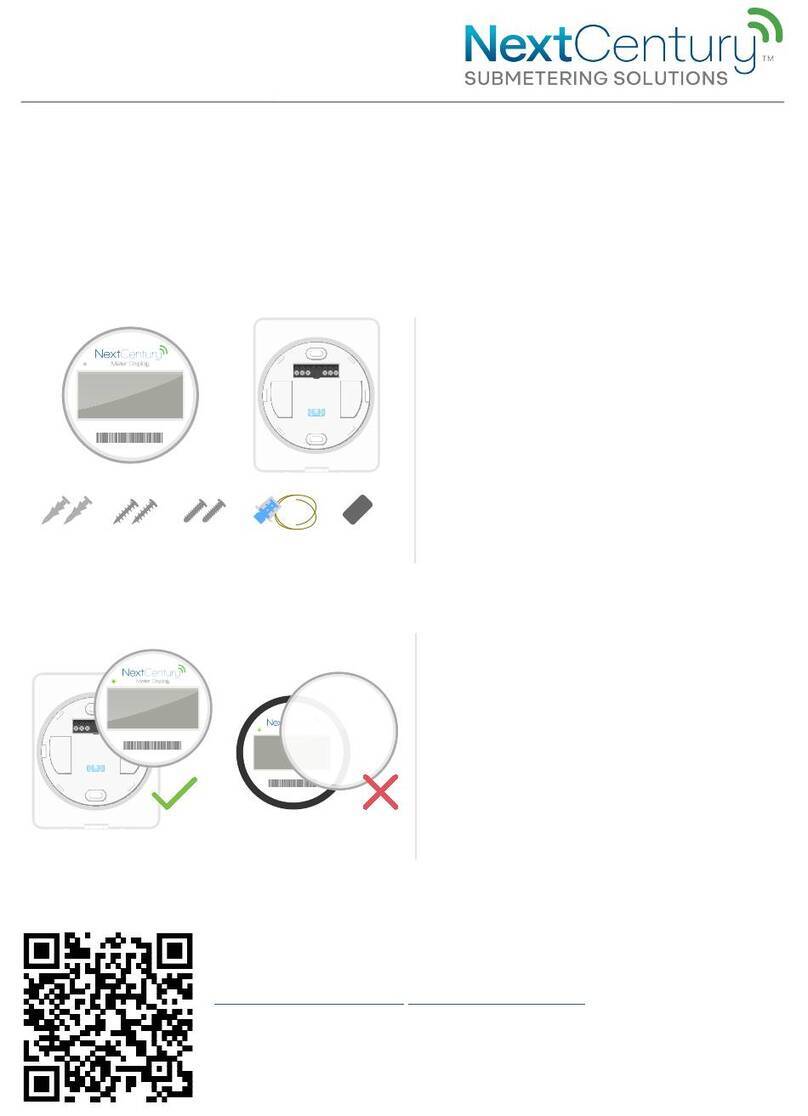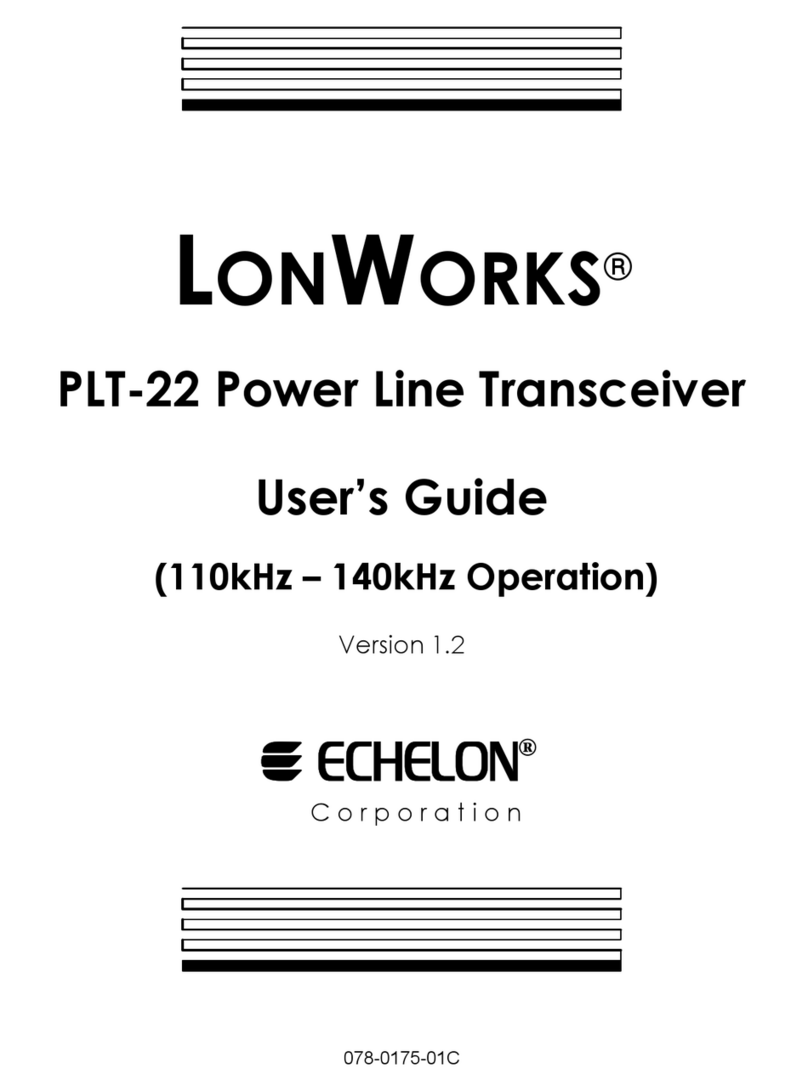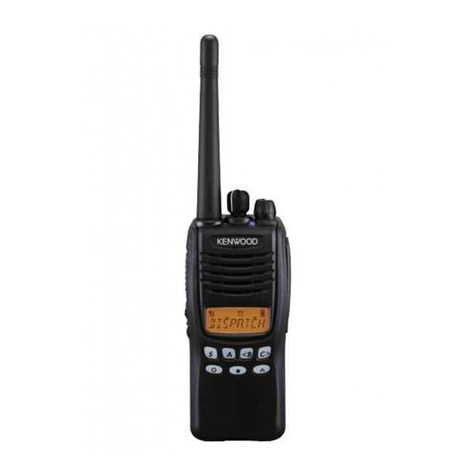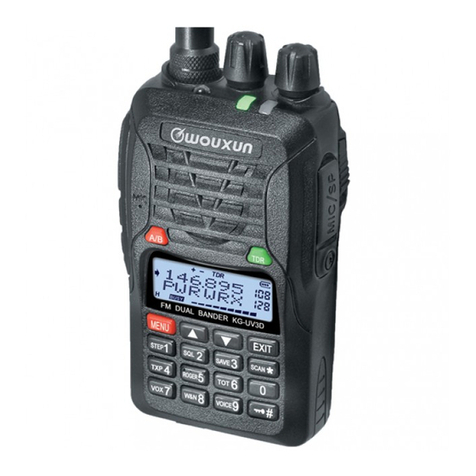Icom IC-M3A User manual

INSTRUCTION MANUAL
iM3A
VHF MARINE TRANSCEIVER
This device complies with Part 15 of the
FCC Rules. Operation is subject to the
condition that this device does not cause
harmful interference.
IC-M3A-(2) 01.12.5 4:19 PM Page A (1,1)

ii
FOREWORD
Thank you for purchasing this Icom product. The IC-M3A VHF
MARINE TRANSCEIVER is designed and built with Icom’s su-
perior technology and craftsmanship. With proper care this
product should provide you with years of trouble-free operation.
IMPORTANT
READ ALL INSTRUCTIONS carefully and com-
pletely before using the transceiver.
SAVE THIS INSTRUCTION MANUAL—This in-
struction manual contains important operating instructions for
the IC-M3A.
EXPLICIT DEFINITIONS
FEATURES
☞Water-resistant construction
Built tough to withstand the punishing marine environ-
ment, the IC-M3A meets JIS water-resistant specification
grade 4.
☞Dual watch and tri-watch functions
Convenient functions which allow you to monitor the dis-
tress channel (ch 16) while receiving a channel of your
choice—dual watch; or monitor the distress channel and
another channel while receiving a channel of your
choice—tri-watch.
☞Large, easy-to-read LCD
With dimensions of 18(H) ×32(W) mm, the IC-M3A’s
function display is easy to read and shows operating con-
ditions at a glance. Backlighting and contrast can be ad-
justed to suit your preferences.
☞Simple operation
Ergonomic design with a minimum number of switches
and controls provides simple intuitive operation.
WORD DEFINITION
RWARNING Personal injury, fire hazard or electric shock
may occur.
CAUTION Equipment damage may occur.
NOTE If disregarded, inconvenience only. No risk
of personal injury, fire or electric shock.
IC-M3A-(2) 01.12.5 4:18 PM Page ii (1,1)

iii
CAUTIONS
RWARNING! NEVER connect the transceiver to an
AC outlet. This may pose a fire hazard or result in an electric
shock.
RWARNING! NEVER hold the transceiver so that the
antenna is very close to, or touching exposed parts of the
body, especially the face or eyes, while transmitting. The
transceiver will perform best if the microphone is 5 to 10 cm
away from the lips and the transceiver is vertical.
NEVER connect the transceiver to a power source other
than the BP-204. Such a connection will ruin the transceiver.
AVOID using or placing the transceiver in direct sunlight or
in areas with temperatures below –20°C (–4°F) or above
+60°C (+140°F).
KEEP the transceiver out of the reach of children.
KEEP the transceiver at least 1 meter away from your ves-
sel’s magnetic navigation compass.
IN CASE OF EMERGENCY
If your vessel requires assistance, contact other vessels and
the Coast Guard by sending a distress call on channel 16.
❍USING CHANNEL 16
DISTRESS CALL PROCEDURE
1. “MAYDAY MAYDAY MAYDAY.”
2. “THIS IS ...........................” (name of vessel)
3. Your call sign or other indication of the ves-
sel.
4. “LOCATED AT .....................” (your position)
5. The nature of the distress and assistance re-
quired.
6. Any other information which might facilitate
the rescue.
IC-M3A-(2) 01.12.5 4:18 PM Page iii (1,1)

iv
FOREWORD ....................................................................... ii
IMPORTANT ........................................................................ ii
EXPLICIT DEFINITIONS ..................................................... ii
FEATURES .......................................................................... ii
CAUTIONS ......................................................................... iii
IN CASE OF EMERGENCY ............................................... iii
TABLE OF CONTENTS ...................................................... iv
1 OPERATING RULES ...................................................... 1
2 PANEL DESCRIPTION ............................................... 2–4
■Front panel .................................................................. 2
■Top and side panels .................................................... 3
■Function display .......................................................... 4
3 BASIC OPERATION ................................................. 5–10
■Channel selection ........................................................ 5
■Lock function ............................................................... 6
■Adjusting the squelch level .......................................... 6
■Receiving and transmitting .......................................... 7
■Call channel programming .......................................... 8
■Automatic backlighting ................................................ 8
4 DUALWATCH/TRI-WATCH ............................................ 9
■Description .................................................................. 9
TABLE OF CONTENTS
■Operation ..................................................................... 9
5 SCAN OPERATION ................................................. 10-11
■Scan types ................................................................. 10
■Setting tag channels .................................................. 11
■Starting a scan ........................................................... 11
6 SET MODE .............................................................. 12-13
■SET mode programming ........................................... 12
■SET mode items ........................................................ 12
7 BATTERY CHARGING ............................................ 14-15
■Installing batteries in the battery case ....................... 14
■Battery charging ........................................................ 14
■Battery cautions ......................................................... 15
8 SUPPLIED ACCESSORIES ......................................... 16
9 TROUBLESHOOTING .................................................. 17
10 CHANNEL LIST ........................................................... 18
11 SPECIFICATIONS AND OPTIONS .............................19
■Specifications ............................................................ 19
■Options ...................................................................... 19
IC-M3A-(2) 01.12.5 4:18 PM Page iv (1,1)

1
1
OPERATING RULES
DPriorities
• Read all rules and regulations pertaining to priorities and
keep an up-to-date copy handy. Safety and distress calls
take priority over all others.
• You must monitor channel 16 when you are not operating
on another channel.
• False or fraudulent distress calls are prohibited under law.
DPrivacy
• Information overheard but not intended for you cannot law-
fully be used in any way.
• Indecent or profane language is prohibited.
DRadio licenses
SHIP STATION LICENSE
When your craft is equipped with a VHF FM transceiver, you
must have a current radio station license before using the
transceiver. It is unlawful to operate a ship station which is not
licensed.
Inquire through your dealer or the appropriate government
agency for a Ship-Radiotelephone license. This license in-
cludes the call sign which is your craft’s identification for radio
purposes.
OPERATOR’S LICENSE
A restricted Radiotelephone Operator Permit is the license
most often held by small vessel radio operators when a radio
is not required for safety purposes.
The Restricted Radiotelephone Operator Permit must be
posted near the transceiver or be kept with the operator. Only
a licensed radio operator may operate a transceiver.
However, non-licensed individuals may talk over a transceiver
if a licensed operator starts, supervises, ends the call and
makes the necessary log entries.
A current copy of the applicable government rules and regu-
lations is only required to be on hand for vessels in which a
radio telephone is compulsory. However, even if you are not
required to have these on hand it is your responsibility to be
thoroughly acquainted with all pertinent rules and regulations.
NOTE: Even though the IC-M3A is capable of operation
on VHF marine channels 3, 21, 23, 61, 64, 81, 82 and 83,
according to FCC regulations these simplex channels can-
not be lawfully used by the general public in USA waters.
IC-M3A-(2) 01.12.5 4:18 PM Page 1 (1,1)

2
2PANEL DESCRIPTION
■Front panel
qDUALWATCH /TRI-WATCH SWITCH
[DW•TRI]
• Starts dualwatch when pushed momentarily.
• Starts tri-watch when pushed for 1 sec.
• Stops dualwatch/tri-watch when either is ac-
tivated.
wSQUELCH SWITCH [SQL]
• Push this switch, then set the squelch level
with the UP/DOWN [ ]/[ ] switches. (p.
6)
eCHANNEL 16 SWITCH [16 •9]
• Selects channel 16 when pushed.
• Selects the call channel when pushed for 1
sec.
• Enters call channel write mode when the
call channel is selected and this switch is
pushed for 3 sec.
rCHANNEL/WEATHER CHANNEL SWITCH
[CH/WX•U/I/C]
• Selects and toggles the regular channels
and weather channel when pushed momen-
tarily.
• Selects one of 3 regular channels in se-
quence when pushed for 1 sec.
- International, U.S.A. and Canadian channels
are available.
tSCAN/TAG SWITCH [SCAN •TAG]
• Starts and stops normal or priority scan
when tag channels are programmed.
• Sets and clears the displayed channel as a
tag (scanned) channel when pushed for 1
sec.
• While pushing this switch, turn the power
ON to clears all tag channels in the selected
regular channel group.
yTRANSMIT POWER/LOCK SWITCH
[H/L •LOCK]
• Toggles high and low power when pushed.
• Toggles the lock function ON/OFF when
pushed for 1 sec.
uCHANNEL UP/DOWN SWITCHES
[ ]/[ ]
• Select an operating channel in the selected
channel group.
• Selects the set mode condition of the item.
TRI
DW
SCAN
H
/
L
SQL
9
U
CH WX
I
//
/
C
TAG
LOCK
iM3A
16
VHF MARINE
w
q
e
r
t
y
u
IC-M3A-(2) 01.12.5 4:19 PM Page 2 (1,1)

3
2
PANEL DESCRIPTION
■Top and side panels
qPTT SWITCH [PTT]
Push and hold to transmit;
release to receive.
wVOLUME CONTROL
[OFF/VOL]
Turns power ON and ad-
justs the audio level.
eANTENNA CONNEC-
TOR
Connects the supplied an-
tenna.
q
w
e
ïBATTERY CASE RELEASE BUTTON
To remove the battery case:
Push and hold the battery release button downwards, then
open the battery case as shown below.
To attach the battery case:
Mate the notched ends of the transceiver and battery
case,and click the battery case into place.
IC-M3A-(2) 01.12.5 4:19 PM Page 3 (1,1)

4
2PANEL DESCRIPTION
■Function display
qTRANSMIT INDICATOR
Appears while transmitting. (p. 8)
wBUSY INDICATOR
Appears when receiving a signal or when the squelch level
is set to the “OFF” position. (p. 8)
eCALL CHANNEL INDICATOR
Appears when the call channel is selected. (p. 9)
rLOW POWER INDICATOR
Shows that low output power is selected.
tWEATHER ALERT INDICATOR
Appears while the weather alert function is activated; blinks
when an alert tone is received.
yLOW BATTERY INDICATOR
Blinks when the battery voltage drops to approx. 6 V or
below. The attached Ni-Cd batteries require charging in this
case.
uLOCK INDICATOR
Appears while the lock function activated.
iSCAN INDICATOR
Blinks while scanning.
oDUALWATCH/TRI-WATCH INDICATORS
“DUAL” appears during dualwatch; “TRI” appears during
tri-watch. (p. 10)
!0 DUPLEX INDICATOR
Appears when a duplex channel is selected.
!1 SET MODE INDICATOR
Shows the set mode items. (pgs. 13)
!2 CHANNEL INDICATOR
• Indicates the selected operating channel number. (p. 6)
• In set mode, indicates the selected condition. (p. 13)
!3 MODE INDICATORS (p. 6)
• “USA” shows that USA channels are selected.
• “CAN” shows that Canadian channels are selected.
• “INT” shows that international channels are selected.
• “WX” shows that weather channels are selected.
!4 TAG CHANNEL INDICATOR
Appears when a tag channel is selected.
BATT
CALL LOW
WX DUP
USA
INT
CAN
BUSYTX
DUAL TRI
ALT SCAN
TAG
qwertyu
!4
!3
!2 !1
i
o
!0
IC-M3A-(2) 01.12.5 4:19 PM Page 4 (1,1)

5
3
BASIC OPERATION
■Channel selection
DChannel 16
Channel 16 is the distress channel. It is used for
establishing initial contact with another station and for
emergency communications. Channel 16 is monitored
during dualwatch/tri-watch. While standing by you are
required to monitor channel 16.
DChannel 9 (Call channel)
Channel 9 is the leisure-use call channel. Each regular
channel group has a separate call channel. The call channel
is monitored during tri-watch. The call channels can be
programmed (p. 9) and are used to store your most often-
used channels in each channel group for quick recall.
• Push [16 • 9] for 1 sec. to select
the call channel for the selected
channel group.
- “CALL” and call channel number
appear.
- Each channel group can have its
own call channel after changing a
call channel.
Push
USA
9
16
CALL
USA
TAG
DU.S.A., Canadian and international channels
There are 61 U.S.A., 57 Canadian and 57 international chan-
nels. These channel groups may be specified for the operat-
ing area.
qPush [CH/WX] to select a regular channel.
- If a weather channel appears, push [CH/WX] again.
wPush [ ]/[ ] switches to select a channel.
- “DUP”appears for duplex channels.
eTo change the channel group, push [CH/WX •U/I/C] for 1
sec.
- U.S.A., Canadian and international channels can be selected in
sequence.
USA
Push for 1 sec.
INT
DUP
U.S.A. channels
Canadian channelsInternational channels
CAN
TAG
U
CH WX
I
//
/
C
U
CH WX
I
//
/
C
U
CH WX
I
//
/
C
IC-M3A-(2) 01.12.5 4:19 PM Page 5 (1,1)

6
3BASIC OPERATION
DWeather channels
There are 10 weather channels. These are used for monitor-
ing weather channels from the NOAA (National Oceano-
graphic and Atmospheric Administration) broadcasts.
The IC-M3A can detect a weather alert tone on a selected
weather channel while scanning. See the “SET mode items”
on p. 12.
•Push [CH/WX] to select weather channels.
■Lock function
This function electronically locks all keys and switches to pre-
vent accidental frequency changes and function access.
•Push [H/L •LOCK] for 1 sec. to turn the lock function ON and
OFF.
- Only [PTT], [H/L] and [SQL] are functional.
USA
Appears when the
lock function is in use.
■Adjusting the squelch level
The IC-M3A has a squelch even
though there is no control knob
for it. In order to receive signals
properly, as well as for scan to
function, the squelch must be
adjusted to a suitable level.
qPush [SQL], then select the squelch level with the [ ]/[ ]
keys.
- There are 11 squelch levels to choose from: OFF is completely
open; 10 is the maximum squelch level.
- When no key pushes within 5 sec., the display returns to normal
indication.
wPush [SQL] once more when the desired squelch level is
indicated in the function display.
- The display returns to normal indication.
Level 10: Max. squelch level
IC-M3A-(2) 01.12.5 4:19 PM Page 6 (1,1)

7
3
BASIC OPERATION
qRotate [OFF/VOL] clockwise to turn power ON, then set
to the 10 o’clock position.
- Use the squelch function to mute any audio noise if necessary.
Refer to the previous page for details.
wPush [ ]/[ ] to select the desired channel.
- When receiving a signal, appears and audio is emitted
from the speaker.
- Further adjustment of [OFF/VOL] may be necessary at this
point.
ePush [H/L] to select the output power if necessary.
- “LOW”appears when low power is selected.
- Choose low power to conserve battery power, choose high
power for longer distance communications.
- Some channels are for low power only.
rPush and hold [PTT] to transmit, then speak into the
microphone.
-appears.
- Channel 70 cannot be used for transmission (for GMDSS use).
tRelease [PTT] to receive.
TX
BUSY
■Receiving and transmitting
CAUTION: Transmitting without an antenna may
damage the transceiver.
IMPORTANT: To maximize the readability of your trans-
mitted signal, pause a few sec. after pushing [PTT], hold
the microphone 5 to 10 cm (2 to 4 inches) from your
mouth and speak at a normal voice level.
NOTE: The transceiver has power save function to con-
serve the battery power and cannot be turned OFF. The
power save function activates automatically when no sig-
nal is received for 5 sec.
qSet volume
wSet channel
eSet output
power
rPush to
transmit
tRelease to
receive
IC-M3A-(2) 01.12.5 4:19 PM Page 7 (1,1)

8
3BASIC OPERATION
■Call channel programming
The call channel switch is used to select channel 9 by default,
however, you can program your most often-used channels in
each channel group for quick recall.
qPush [CH/WX •U/I/C] for 1 sec.
several times to select the de-
sired channel group (USA, INT,
CAN) to be programmed.
wPush [16 •9] for 1 sec. to select
the call channel of the selected
channel group.
- “CALL”and call channel number
appear.
ePush [16 •9] again for 3 sec.
(until long beep changes to 2
short beeps) to enter call chan-
nel programming condition.
- Call channel number and channel
group to be programmed flash.
rPush [ ]/[ ] to select the de-
sired channel.
tPush [16 •9] to program the dis-
played channel as the call chan-
nel.
- The call channel number and chan-
nel group stop flashing.
■Automatic backlighting
This function is convenient for nighttime operation. The auto-
matic backlighting can be activated in SET mode. (p. 12)
•Push any key except for [PTT] to turn the backlighting ON.
- The backlighting is automatically turned OFF after 5 sec. of in-
activity.
USA
TAG
CALL
USA
TAG
CALL
USA
TAG
CALL
USA
TAG
CALL
USA
TAG
IC-M3A-(2) 01.12.5 4:19 PM Page 8 (1,1)

9
4
DUALWATCH/TRI-WATCH
■Description
Dualwatch monitors channel 16 while you are receiving an-
other channel; tri-watch monitors channel 16 and the call
channel while receiving another channel.
DUALWATCH/TRIWATCH SIMULATION
•If a signal is received on channel 16, dualwatch/tri-watch pauses
on channel 16 until the signal disappears.
•If a signal is received on the call channel during tri-watch, tri-
watch becomes dualwatch until the signal disappears.
•To transmit on the selected channel during dualwatch/tri-watch,
push and hold [PTT].
Call channel
Dualwatch Tri-watch
■Operation
qSelect the desired operating channel.
wPush [DW •TRI] momentarily to start dualwatch; push [DW
•TRI] for 1 sec. to start tri-watch.
- “DUAL”flashes during dualwatch; “TRI”flashes during tri-watch.
- Beep tones sound when a signal is received on channel 16.
- Tri-watch becomes dualwatch when receiving a signal on the call
channel.
eTo cancel dualwatch/tri-watch, push [DW •TRI] again.
[Example]: Operating tri-watch on INT channel 07.
DUP
INT
TRI
TAG
CALL
INT
BUSY
TRI
TAG
DUP
DUP
INT
BUSY
TRI
TAG
INT
TRI
TAG
Tri-watch starts.
Push for 1 sec.
Signal is received
on call channel.
Signal received on
channel 16 takes
priority.
Tri-watch resumes
after the signal
disappears.
TRI
DW
IC-M3A-(2) 01.12.5 4:19 PM Page 9 (1,1)

10
5SCAN OPERATION
■Scan types
Scanning is an efficient way to locate signals quickly over a
wide frequency range. The transceiver has a priority scan and
a normal scan.
In addition, weather alert functions is available for standby
convenience. (p. 13)
Set the tag channels (channels to be scanned) before scan-
ning. Clear the tag channels which inconveniently stop scan-
ning, such as those used for digital communications.
NOTE: Choose priority or normal scan in SET mode. (P. 12)
PRIORITY SCAN
Priority scan searches through all tag channels in se-
quence while monitoring channel 16. When a signal is de-
tected on channel 16, scan pauses until the signal
disappears; when a signal is detected on a channel other
than channel 16, scan becomes dualwatch until the signal
disappears.
WX*
CH 01
CH 16
CH 02
CH 05 CH 04
CH 03
* Previously selected weather channel
when weather alert function is ON.
NORMAL SCAN
Normal scan, like priority scan, searches through all tag
channels in sequence. However, unlike priority scan, chan-
nel 16 is not checked unless channel 16 is set as a tag
channel.
CH 01 CH 02
WX*
CH 05 CH 04
CH 03
* Previously selected weather channel
when weather alert function is ON.
IC-M3A-(2) 01.12.5 4:19 PM Page 10 (1,1)

11
5
SCAN OPERATION
■Setting tag channels
For more efficient scanning, add desired channels as tag
channels or clear tag channels for unwanted channels. Chan-
nels set as non-tag channels will be skipped during scanning.
Tag channels can be assigned to each channel group (USA,
CAN, INT) independently.
qSelect the desired channel group (USA, CAN, INT) by
pushing [CH/WX •U/I/C] for 1 sec., if desired.
wSelect the desired channel to set as a tag channel.
ePush [SCAN •TAG] for 1 sec. to set the displayed channel
as a tag channel.
- appears in the function display.
rTo cancel the tag channel setting, push [SCAN •TAG] for 1
sec.
- disappears.
•Clearing all tag channels in the selected channel group
While pushing [SCAN •TAG], turn the power ON to clear all
tag channels in the channel group.
TAG
TAG
■Starting a scan
Set scan type, weather alert function and scan resume timer
in advance using SET mode. (p. 13)
qSelect the desired channel group (USA, CAN, INT) by
pushing [CH/WX •U/I/C] for 1 sec., if desired.
- When the weather alert function is in use, select the desired
weather channel with [CH/WX] and the channel selector.
wPush [SCAN •TAG] to start priority or normal scan.
- “SCAN”appears and flashes in the function display.
- “16”appears during priority scan.
- When a signal is detected, scan pauses until the signal disap-
pears or resumes after pausing 5 sec. according to SET mode
setting. (Channel 16 is still monitored during priority scan.)
- Push [ ]/[ ] to check tag channels, to change the scanning
direction or resume the scan manually.
eTo stop the scan, push [SCAN •TAG].
- “SCAN”disappears.
- Pushing [PTT], [16 •9], [CH/WX] or [DW •TRI] also stops the
scan.
Scan starts.
Scan pauses when receiving a
signal and audio is emitted.
USA
SCAN
TAG
USA USA
BUSY
SCAN
TAG
Push Push to stop
the scan.
SCAN
TAG
SCAN
TAG
[Example]: Starting a normal scan.
IC-M3A-(2) 01.12.5 4:19 PM Page 11 (1,1)

12
6SET MODE
■SET mode programming
SET mode is used to change the conditions of 6 transceiver
functions: the beep tone function, the automatic backlighting,
weather alert function, normal/priority scan, scan resume
timer and power save function.
qTurn power OFF.
wWhile pushing [SQL], turn power ON and continue push-
ing [SQL] until “bP”appears.
eRelease [SQL].
rPush [SQL] to select the desired item, if necessary.
tPush [ ]/[ ] to select the desired condition of the item.
yTo exit SET mode, turn the power OFF, then ON again.
•SET MODE CONSTRUCTION
Automatic
backlighting
Weather alert
Scan resume
timer
Scan type
Beep tone
Power save
Push
SQL
■SET mode items
DBeep tone “bP”
You can select silent operation by turning beep tones OFF or
you can have confirmation beeps sound at the push of a
switch by turning beep tones ON. The beep tone volume is
linked with [OFF/VOL].
DAutomatic backlighting “bL”
This function is convenient for nighttime operation. The auto-
matic backlighting turns the backlighting ON when pushing
any key except for [PTT].
•The backlighting is automatically turned OFF after 5 sec. of inactiv-
ity.
Beep tone ON (default)
Automatic backlighting ON (default)
IC-M3A-(2) 01.12.5 4:19 PM Page 12 (1,1)

13
6
SET MODE
DWeather alert function “AL”
NOAA broadcast stations transmit weather alert tones before
important weather announcements. When the weather alert
function is turned ON, the transceiver detects the alert, then
flashes the “ALT”indicator until the transceiver is operated.
The previously selected (used) weather channel is checked
periodically during standby or while scanning.
•“ALT”appears when the function is set ON.
DScan type selection “SC”
The transceiver has 2 scan types: normal scan and priority
scan. Normal scan searches all tag channels in the selected
channel group. Priority scan searches all tag channels in se-
quence while monitoring channel 16.
DScan resume timer “St”
The scan resume timer can be selected as a pause (OFF) or
timer scan (ON). When OFF is selected, the scan pauses
until a received signal disappears. When ON is selected, the
scan pauses for 5 sec. after receiving a signal and then re-
sumes even if the signal is still being received.
DAuto power save function “PS”
The power save function reduces current drain by deactivat-
ing the receiver circuit for preset intervals.
Weather alert function OFF (default)
Normal scan (default) Priority scan
Scan timer OFF (default)
Power save ON (default)
IC-M3A-(2) 01.12.5 4:19 PM Page 13 (1,1)

14
7BATTERY CHARGING
■Installing batteries in the bat-
tery case
When using a battery case attached to the transceiver, install
6 AA(R6) size Ni-Cd or alkaline batteries as illustrated below.
qRemove the battery case from the transceiver.
wInstall 6 ×AA(R6) size Ni-Cd or alkaline batteries.
•Be sure to observe the correct polarity.
CAUTION:
•When installing batteries, make sure they are all the
same brand, type and capacity. Also, do not mix new and
old batteries together.
•Keep battery contacts clean. It’s a good idea to clean
battery terminals once a week.
■Battery charging
Prior to using the transceiver for the first time, the Ni-Cd bat-
teries must be fully charged for optimum life and operation.
•Recommended temperature range for charging:
+50°F to +104°F (+10°C to +40°C)
•Use the supplied AC adapter (BC-131A) only. NEVER use
other adapters.
•An optional cable OPC-254L (for 12 V power source) or CP-
12L (for 12 V cigarette lighter socket) can be used instead of
the supplied AC adapter.
Before connecting DC power, make sure the internal
switch is set to the proper battery type—Ni-Cd or alkaline.
NEVER connect DC power to the battery case when in-
stalling alkaline batteries. Such a connection will damage
the transceiver.
CAUTION: To avoid damage to the transceiver, turn it
OFF while charging.
Ni-Cd ••ALKALINE
IC-M3A-(2) 01.12.5 4:19 PM Page 14 (1,1)

15
7
BATTERY CHARGING
■Battery cautions
NEVER incinerate used Ni-Cd batteries. Internal battery gas
may cause an explosion.
NEVER immerse batteries in water. If the battery case be-
comes wet, be sure to wipe it dry BEFORE attaching it to the
transceiver.
NEVER short terminals of the battery case. Also, current may
flow into nearby metal objects so be careful when placing bat-
tery cases in handbags, etc.
If your Ni-Cd batteries seem to have no capacity even after
being charged, completely discharge them by leaving the
power ON overnight. Then, fully charge the Ni-Cd batteries
again. If the Ni-Cd batteries still do not retain a charge (or
very little), new Ni-Cd batteries must be purchased.
DRecycling information
The product that you have purchased con-
tains a rechargeable battery. The battery is
recyclable. At the end of its life, under vari-
ous state and local laws, it may be illegal to
dispose of this battery into the municipal
waste stream. Call 1-800-8-BATTERY for
battery recycling options in your area or contact your dealer.
RBRC
RBRC
Ni-
Cd
ïCharging connections
qInstall 6 AA(R6) size Ni-Cd batteries into the battery case.
wTurn the battery selector switch to the Ni-Cd position.
eConnect the AC adapter (BC-131A) or optional cable (CP-
12L or OPC-254L) as shown below.
- The charge indicator lights red.
rCharge the Ni-Cd batteries for 15 hours.
BC-131A
OPC-254L or
CP-12L
CAUTION: Make sure the [CHARGE] switch is in the
ALKALINE position when operating the transceiver with
alkaline batteries.
IC-M3A-(2) 01.12.5 4:19 PM Page 15 (1,1)

16
8SUPPLIED ACCESSORIES AND ATTACHMENT
DSupplied accessories
The following accessories are supplied:
Qty.
qFlexible antenna . . . . . . . . . . . . . . . . . . . . . . . . . . . . .1
wBelt clip . . . . . . . . . . . . . . . . . . . . . . . . . . . . . . . . . . . .1
eHandstrap . . . . . . . . . . . . . . . . . . . . . . . . . . . . . . . . . .1
rBattery case (BP-204) with 6 Ni-Cd (AA) batteries . . .1
tAC adapter* . . . . . . . . . . . . . . . . . . . . . . . . . . . . . . . . .1
* Not supplied with some versions.
DFlexible antenna
Connect the supplied flexible
antenna to the antenna con-
nector.
CAUTION: Transmitting
without an antenna may
damage the transceiver.
DBelt clip
To attach: Slide the belt clip into the plastic loop on the back of
the battery case.
To remove: Push the top of the belt clip towards the transceiver
and out at the same time, then push it downwards and free of the
plastic loop.
DHandstrap
Slide the handstrap through
the loop on the side of the
transceiver as illustrated at
right. Facilitates carrying.
IC-M3A-(2) 01.12.5 4:19 PM Page 16 (1,1)
Table of contents
Other Icom Transceiver manuals
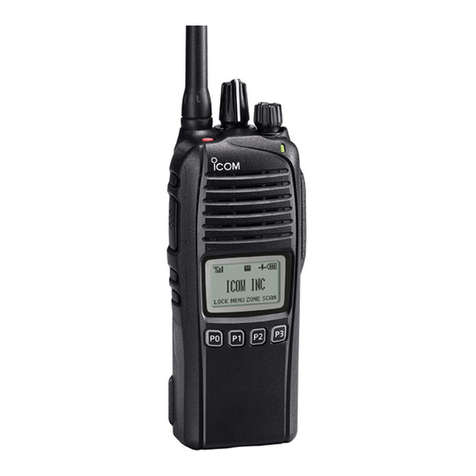
Icom
Icom IC-F3360D Series User manual
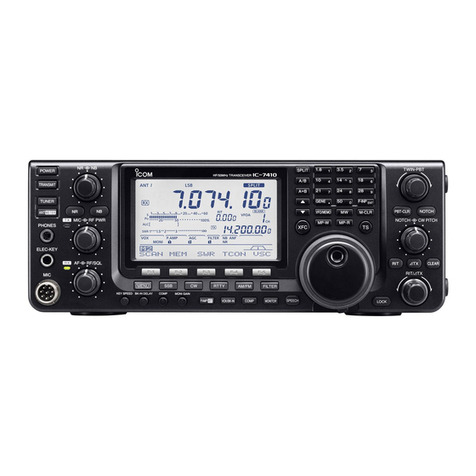
Icom
Icom IC-7410 User manual
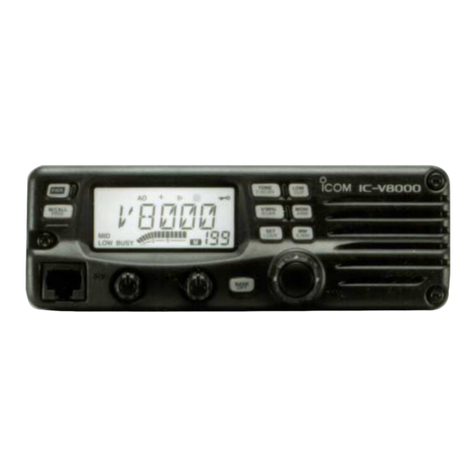
Icom
Icom IC-V8000 User manual
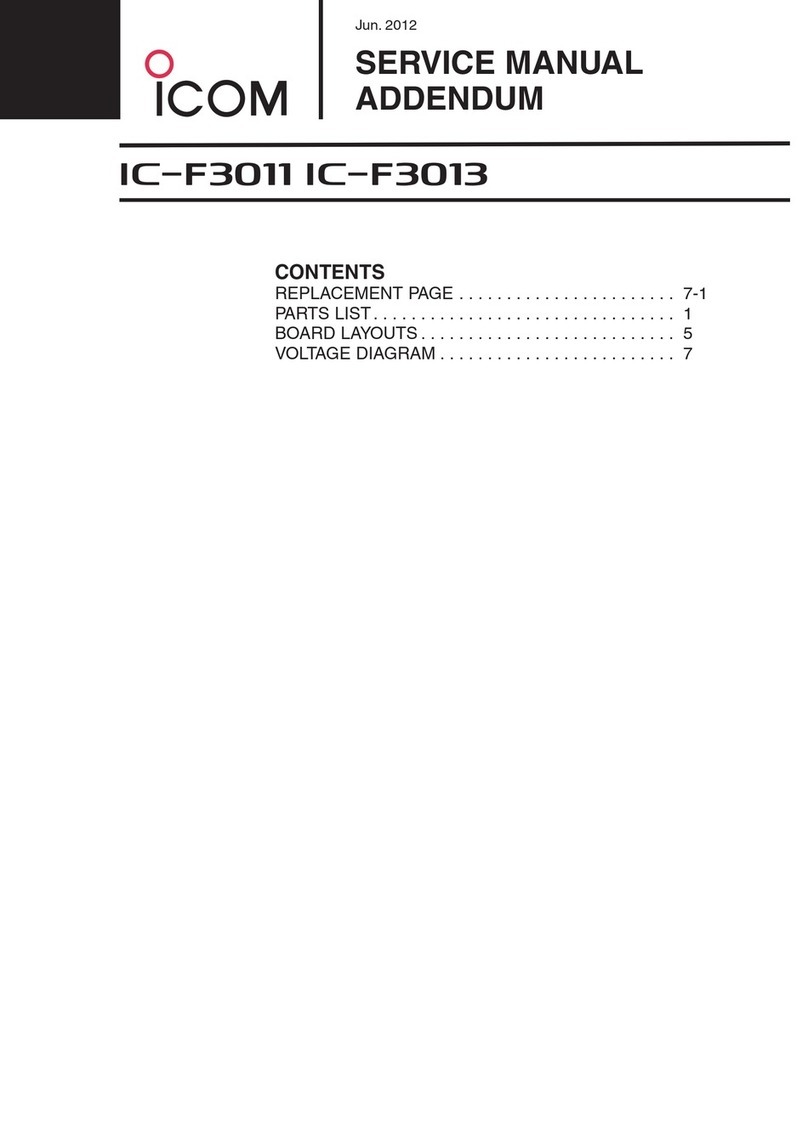
Icom
Icom IC-F3011 Installation and operating instructions
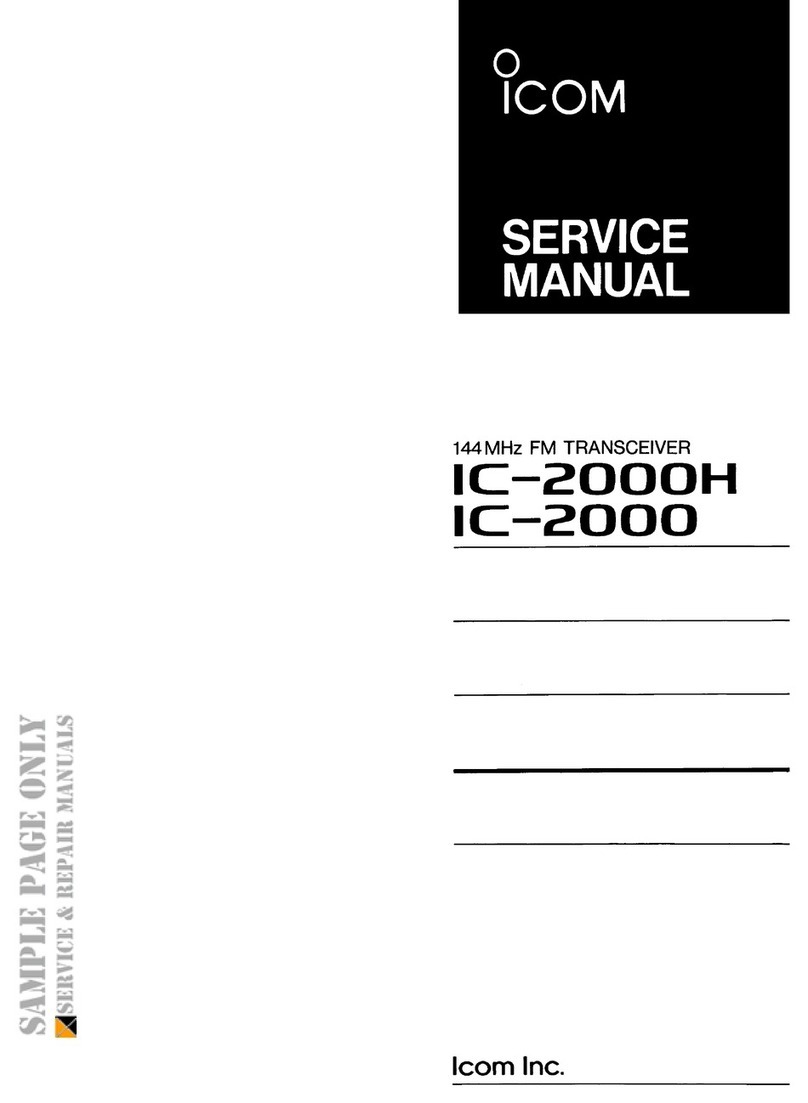
Icom
Icom IC-2000H User manual
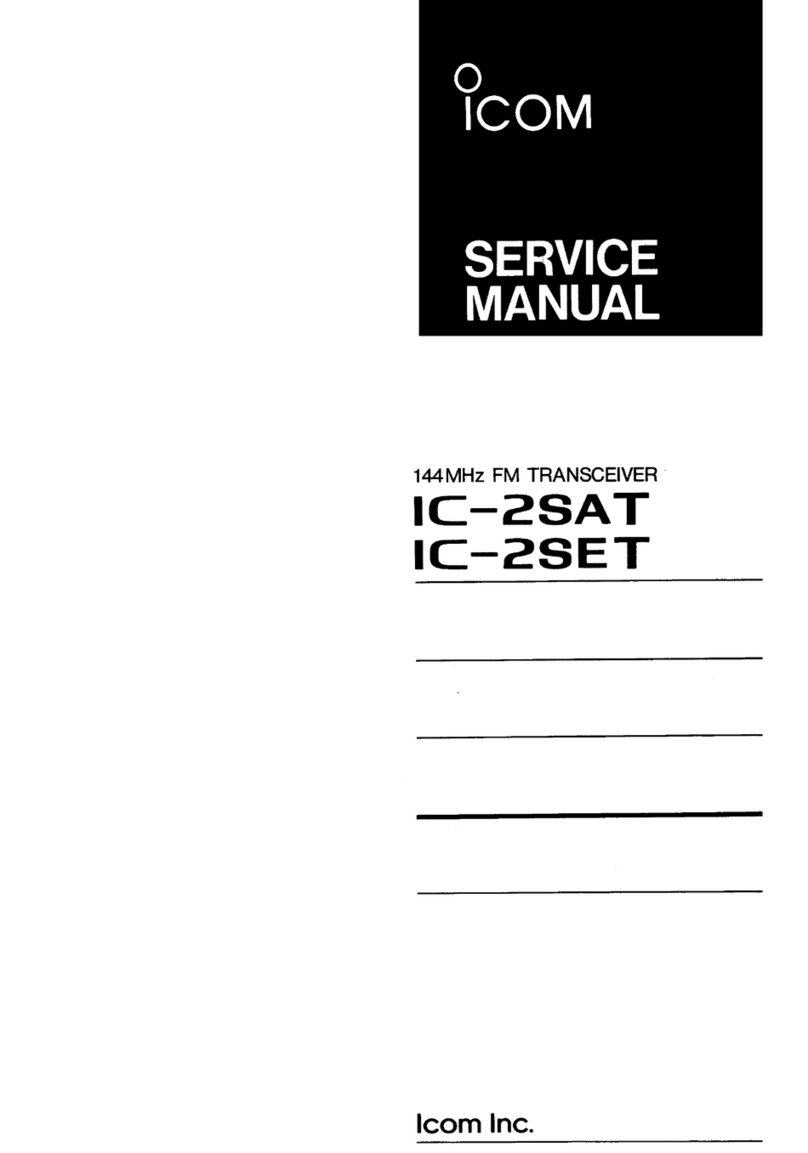
Icom
Icom IC-2SET User manual
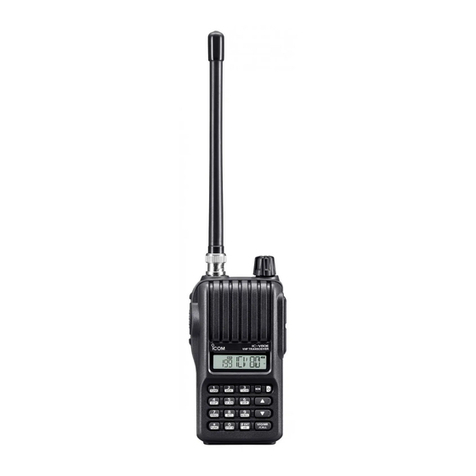
Icom
Icom IC-V80 User manual
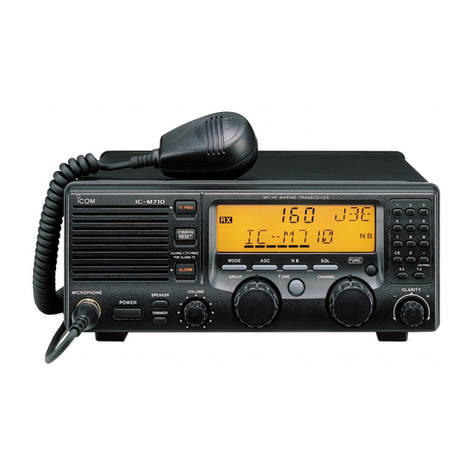
Icom
Icom IC-M710 User manual
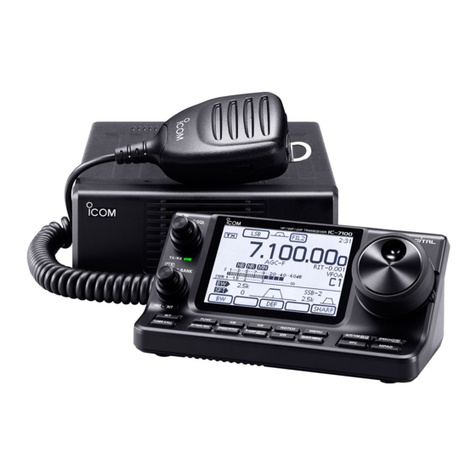
Icom
Icom IC-7100 Installation and operating instructions
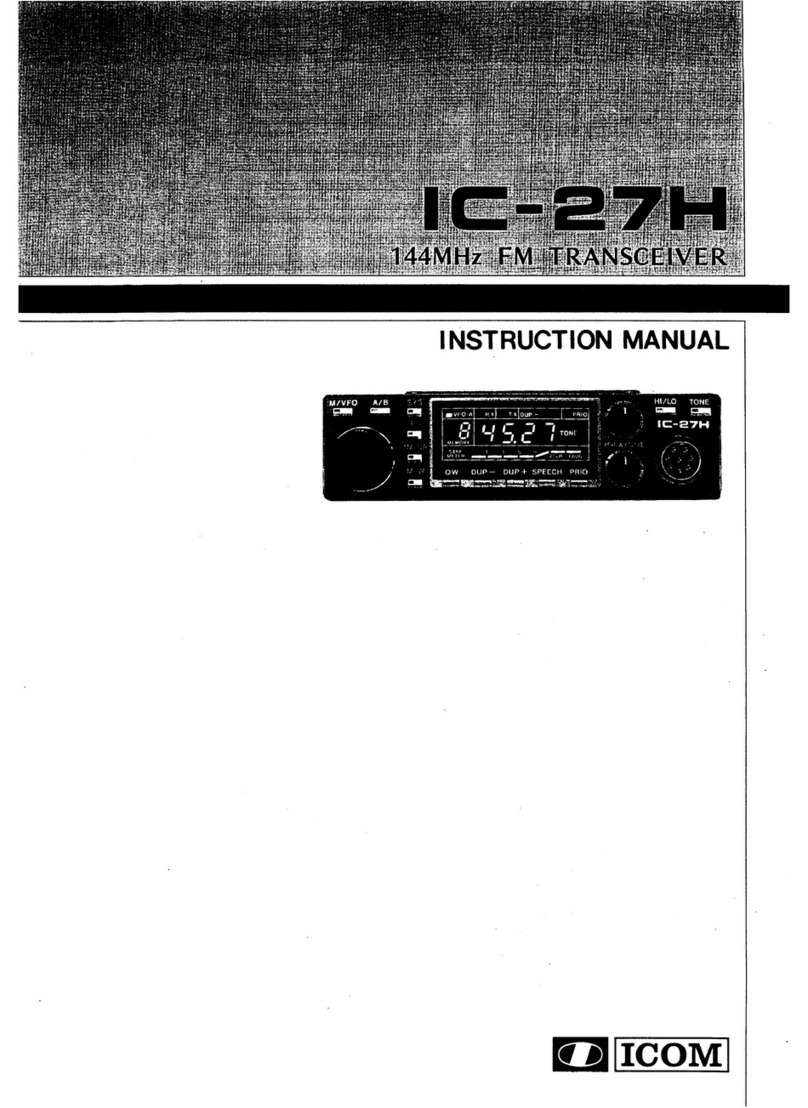
Icom
Icom IC-27H User manual
